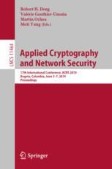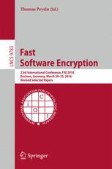Search
Search Results
-
From Farfalle to Megafono via Ciminion: The PRF Hydra for MPC Applications
The area of multi-party computation (MPC) has recently increased in popularity and number of use cases. At the current state of the art, Ciminion, a...
-
Improved Multi-user Security Using the Squared-Ratio Method
Proving security bounds in contexts with a large number of users is one of the central problems in symmetric-key cryptography today. This paper...
-
Private Set Operations from Multi-query Reverse Private Membership Test
Private set operations allow two parties to perform secure computation on their private sets, including intersection, union and functions of...
-
The Summation-Truncation Hybrid: Reusing Discarded Bits for Free
A well-established PRP-to-PRF conversion design is truncation: one evaluates an n-bit pseudorandom permutation on a certain input, and truncates the...
-
Quantum Attacks on PRFs Based on Public Random Permutations
Plenty of permutation-based pseudorandom functions (PRFs) were proposed. In order to analyze their quantum security uniformly, we proposed three...
-
Lightweight, Maliciously Secure Verifiable Function Secret Sharing
In this work, we present a lightweight construction of verifiable two-party function secret sharing (FSS) for point functions and multi-point...
-
Beyond-birthday secure domain-preserving PRFs from a single permutation
This paper revisits the fundamental cryptographic problem of building pseudorandom functions (PRFs) from pseudorandom permutations (PRPs). We prove...

-
How to Build Optimally Secure PRFs Using Block Ciphers
In EUROCRYPT ’96, Aiello and Venkatesan proposed two candidates for 2n-bit to 2n-bit pseudorandom functions (PRFs), called Benes and modified Benes...
-
Ciminion: Symmetric Encryption Based on Toffoli-Gates over Large Finite Fields
Motivated by new applications such as secure Multi-Party Computation (MPC), Fully Homomorphic Encryption (FHE), and Zero-Knowledge proofs (ZK), the...
-
How to Build Pseudorandom Functions from Public Random Permutations
Pseudorandom functions are traditionally built upon block ciphers, but with the trend of permutation based cryptography, it is a natural question to...
-
Parallelizable MACs Based on the Sum of PRPs with Security Beyond the Birthday Bound
The combination of universal hashing and encryption is a fundamental paradigm for the construction of symmetric-key MACs, dating back to the seminal...
-
Tweaking a block cipher: multi-user beyond-birthday-bound security in the standard model
In this paper, we present a generic construction to create a secure tweakable block cipher from a secure block cipher. Our construction is very...
-
Hardness-Preserving Reductions via Cuckoo Hashing
The focus of this work is hardness-preserving transformations of somewhat limited pseudorandom functions families (PRFs) into ones with more...

-
Encrypt or Decrypt? To Make a Single-Key Beyond Birthday Secure Nonce-Based MAC
At CRYPTO 2016, Cogliati and Seurin have proposed a highly secure nonce-based MAC called Encrypted Wegman-Carter with Davies-Meyer (...
-
Pseudonymous Signature Schemes
The chapter concerns cryptographic schemes enabling to sign digital data in a pseudonymized way. The schemes aim to provide a strong cryptographic...
-
XOR of PRPs in a Quantum World
In the classical world, the XOR of pseudorandom permutations...
-
On rate-1 and beyond-the-birthday bound secure online ciphers using tweakable block ciphers
Recently, Andreeva et al. showed that online ciphers are actually equivalent to arbitrary tweak length (ATL) tweakable block ciphers (TBCs). Within...

-
EWCDM: An Efficient, Beyond-Birthday Secure, Nonce-Misuse Resistant MAC
We propose a nonce-based MAC construction called EWCDM (Encrypted Wegman-Carter with Davies-Meyer), based on an almost xor-universal hash function...
-
A MAC Mode for Lightweight Block Ciphers
Lightweight cryptography strives to protect communication in constrained environments without sacrificing security. However, security often conflicts...
